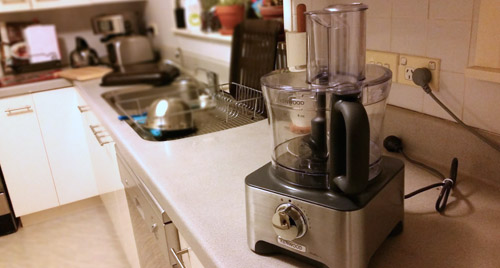 Recently my trusty mini food processor fought its last battle – turns out that despite managing to cut and grind just about everything I threw in it, the one thing that killed it in the end was candy canes (I was hosting a baby shower with a hot chocolate self service bar and wanted crushed candy canes as an option for guests to sprinkle into their hot chocolates…fail).
Recently my trusty mini food processor fought its last battle – turns out that despite managing to cut and grind just about everything I threw in it, the one thing that killed it in the end was candy canes (I was hosting a baby shower with a hot chocolate self service bar and wanted crushed candy canes as an option for guests to sprinkle into their hot chocolates…fail).
This resulted in the perfect opportunity to buy a bigger food processor, and one capable of more tasks as my daughter fast approaches six months which inevitably involves the adventure of pureeing, mashing and blending solids for her.
Here’s how I found my ideal food processor.
What do you need it for?
I think I’ve learned my lesson that a small, cheap food processor can’t crush candy canes, but I’ve had friends break their food processors by simply processing tough ingredients regularly such as raw pumpkin, carrots or nuts. Because of this, if you’re looking for a longer lasting appliance, you really need to be purchasing a processor with a little more grunt.
Different food processors may be more capable of performing different functions. Ideally I needed something to make curry pastes from scratch and to create home made baby food. If it could make decent bliss balls, banana ice cream and soups, this would be an added bonus. Take your requirements into consideration before you buy as you don’t want to purchase a food processor to later find out it doesn’t do what you want it to.
The other options
Size. To create meals for a family, you should be looking at a processor with a bowl of around 2.5 to 3 litres.
Blades. The best quality blades are made of stainless steel. Anything less and you may find they deteriorate easier. More expensive processors may come with additional blades for performing tasks such as grinding, making potato chips or grating.
Speed. How fast do you want to process ingredients? Some machines can process at a variety of speeds, while others may only have ‘on’ or ‘off’.
Power/wattage. A processor with around 700W or more should perform most activities. Less than this and the appliance may struggle with processing certain ingredients or carrying out more taxing tasks such as mixing dough.
Length of warranty and whether the appliance parts are dishwasher-safe may also be good things to consider.
How much should you pay?
You typically do get what you pay for; a more expensive food processor may be more durable, and/or may come with extra features such as various attachments for tasks such as dicing, grinding, making potato chips or juicing.
Sometimes with higher end brands, you can end up paying extra just for the brand name. This is only worth it if it has a good reputation for being long-lasting or of great quality.
A basic standard-sized standalone food processor will typically set you back around $150 if not on sale. At the other end of the scale, for a reputable-branded food processor with all the attachments you could be looking at paying upwards of $500.
So what did I end up with?
I believe in buying the best appliances I can afford, but waiting for a decent sale so that I get the best value for my money so hit the end of year sales and ended up with a Kenwood FDM785BA.
Although a basic food processor would have done the majority of the tasks I wanted, this one has a blender capable of blending hot/cold ingredients (perfect for making soups), a grinder (more suited to nuts and spices) and a variety of blades and attachments.
To sum up
If you’re thinking about getting a new food processor, look at the purpose you want to use it for, the power/wattage, the speed for processing, the cost for it to fit within your budget, bowl size, and the strength of the blades. Also take into consideration the warranty it comes with and whether the parts are dishwasher-safe if you’re planning on cleaning it that way.
Image / NZ Real Health

